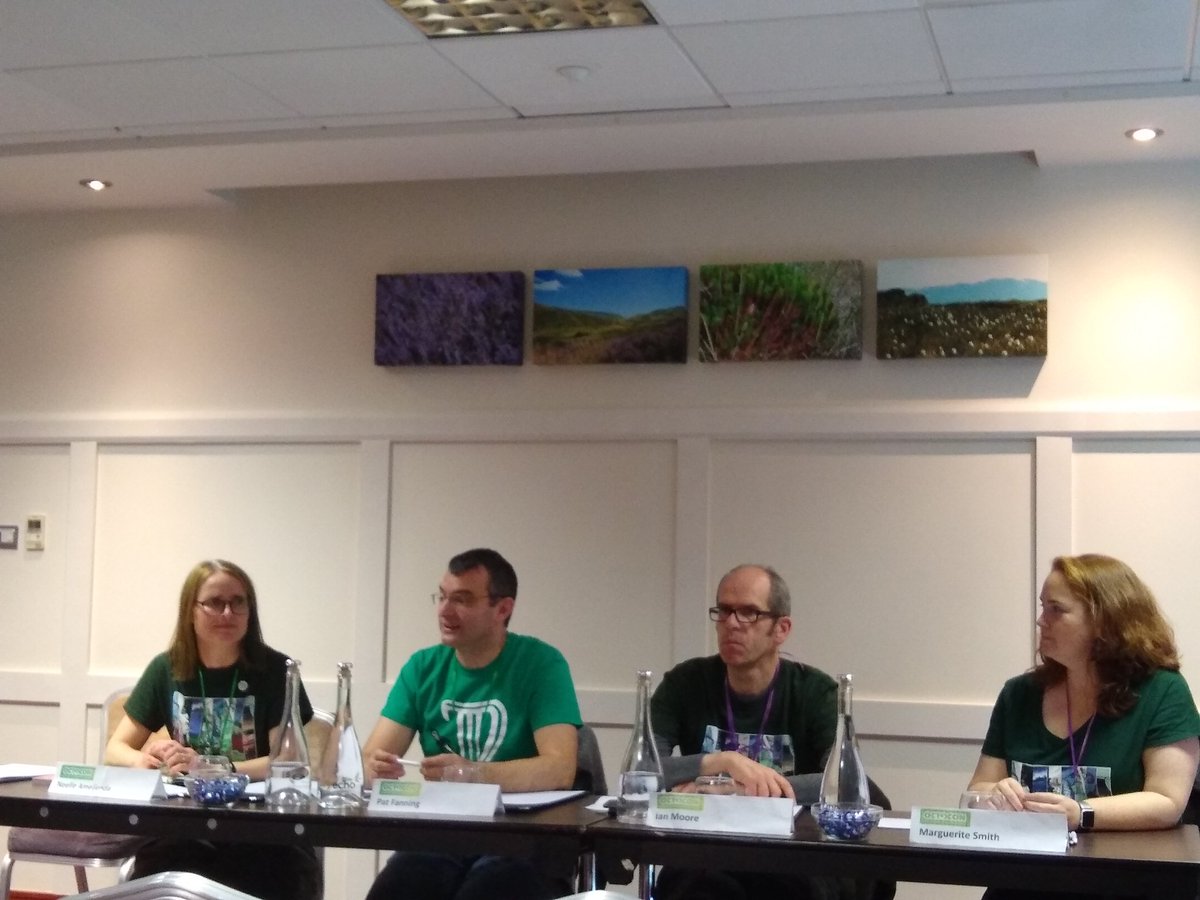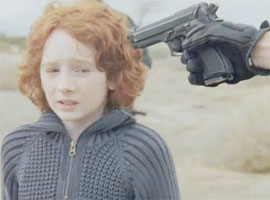Saturday morning saw me first of all working on the Octocon reception desk, where we dealt with registering convention attendees as they arrived. If you arrived at Octocon on Saturday morning then maybe mine was the friendly face that greeted you (or the surly jobsworth who couldn't find your reservation). I made friends with some pandas who had come to the convention to examine Octocon's Hugo trophy.
The morning also saw me make my debut as an Octocon panellist. As part of my efforts to promote the World Science Fiction Convention that is coming to Dublin next year I took part in a panel intended to drum up enthusiasm for volunteering at Worldcon. It turned out we were rather talking to the converted as almost everyone present was already volunteering for Worldcon, but this did allow us to gang up on the others. If anyone reading this is not a Worldcon volunteer then I encourage you to get involved, as volunteering is fun, a way of meeting people, a way of giving something back to science fiction and a way of seeing the inside of what will be the biggest science fiction event to ever come to Ireland.
 More time on the reception desk and then my own interest in lunch meant that the next event I attended was the guest of honour interview by Octocon chair Janet O’Sullivan with Pat Cadigan, an American science fiction writer who now lives in England. I was not previously familiar with her work (which is more a reflection on me than on her as I am a slow reader and am unfamiliar with most writers). I found the interview fascinating, as any question would set Cadigan off on a stream of anecdote that would lead very far from the initial starting point. I particularly liked her favourable recollection of Robert Heinlein, someone who now is perhaps unfairly and simplistically pigeon-holed as a right-wing ultra, but whom she recalls as a very generous character. I was also touched by the particularly star-struck question from a member of the audience and Cadigan’s gracious response.
More time on the reception desk and then my own interest in lunch meant that the next event I attended was the guest of honour interview by Octocon chair Janet O’Sullivan with Pat Cadigan, an American science fiction writer who now lives in England. I was not previously familiar with her work (which is more a reflection on me than on her as I am a slow reader and am unfamiliar with most writers). I found the interview fascinating, as any question would set Cadigan off on a stream of anecdote that would lead very far from the initial starting point. I particularly liked her favourable recollection of Robert Heinlein, someone who now is perhaps unfairly and simplistically pigeon-holed as a right-wing ultra, but whom she recalls as a very generous character. I was also touched by the particularly star-struck question from a member of the audience and Cadigan’s gracious response. Cadigan also mentioned having previously attended some class of event called a relaxacon. I don't know what these are but I want to go to one.
As you know, this is the 200th anniversary of the publication of Mary Shelley’s Frankenstein and with it the birth of science fiction. Octocon had an entire programming strand engaging with Frankenstein’s legacy and I now found myself attending a panel discussion on the Monster’s perspective. This got a bit “could it be that we are the real monster?” but I was struck by the discussion of consent issues (e.g. Frankenstein’s Monster badgering him to create a Lady Monster for him, taking for granted that she will want to be his mate). More general discussion of how a simple shift of perspective can make monsters appear like victims led to an interesting recollection by one panellist of a story they read once about people in the remote past fighting Trolls, where the reader realises that the Trolls are the last Neanderthals being hunted to extinction; it occurs to me now that another work of this kind is I Am Legend, the 1954 novel by Richard Matheson, where the book ends with the protagonist’s realisation that he is a monster to the vampiric new humans (I wish I had thought of this at the panel and established my remembering-things-about-books-I-have-read credentials by mentioning it). I was also reminded of various works in 2000 AD by Pat Mills, where his writing was very evocative of the non-human mindset of dinosaurs and other monstrous creatures.
Of the panellists' own works, Sarah Maria Griffin's take on Frankenstein, in which a brainy teenage girl attempts to build herself a boyfriend, sounds like it might have a Christmas present date with my niece.
The last programme item I made it to on the Saturday was the Vault of Horror. This is always a highlight of Octocon but it is also an event that is hard to describe in a way that does not make it sound a bit rubbish if you have never experienced it. The Vault sees John Vaughan playing snippets from a terrible film and drawing attention to the film's awfulness. He does this in a way that is actually funny rather than being some smug guy making fun of other people's attempts at making films. This year he reported that he has almost run out of terrible films but then he had found a terrible Gerard Butler vehicle called Geostorm with which to delight us. He also provided us with the sad news that due to a progressive illness he will not be in a position to continue serving up the Vault indefinitely into the future, but he will next year be bringing the Vault to Worldcon and presenting one of the most terrible of the films with which he has previously charmed Octocon. Are you coming to Worldcon? Then you will come to the Vault, you will.
I sadly ate so much food for dinner at this point (a recurring theme for me at Science Fiction conventions) that I was too disgustingly full to enjoy the Monsters Ball and left early, thinking that next year is definitely the one where I find some kind of easy cosplay outfit to wear.
Octocon day 3 report coming soon.
Putting the 'Irish' into An Irish Worldcon panellists image source (@jc_ie on Twitter)
See also:
Octocon website
Another view of Octocon Day 2, from blog name of Not Another Book Blogger.





/arc-anglerfish-tgam-prod-tgam.s3.amazonaws.com/public/M6Q7E3GWVFFANJZIR2D4LJL42E)
